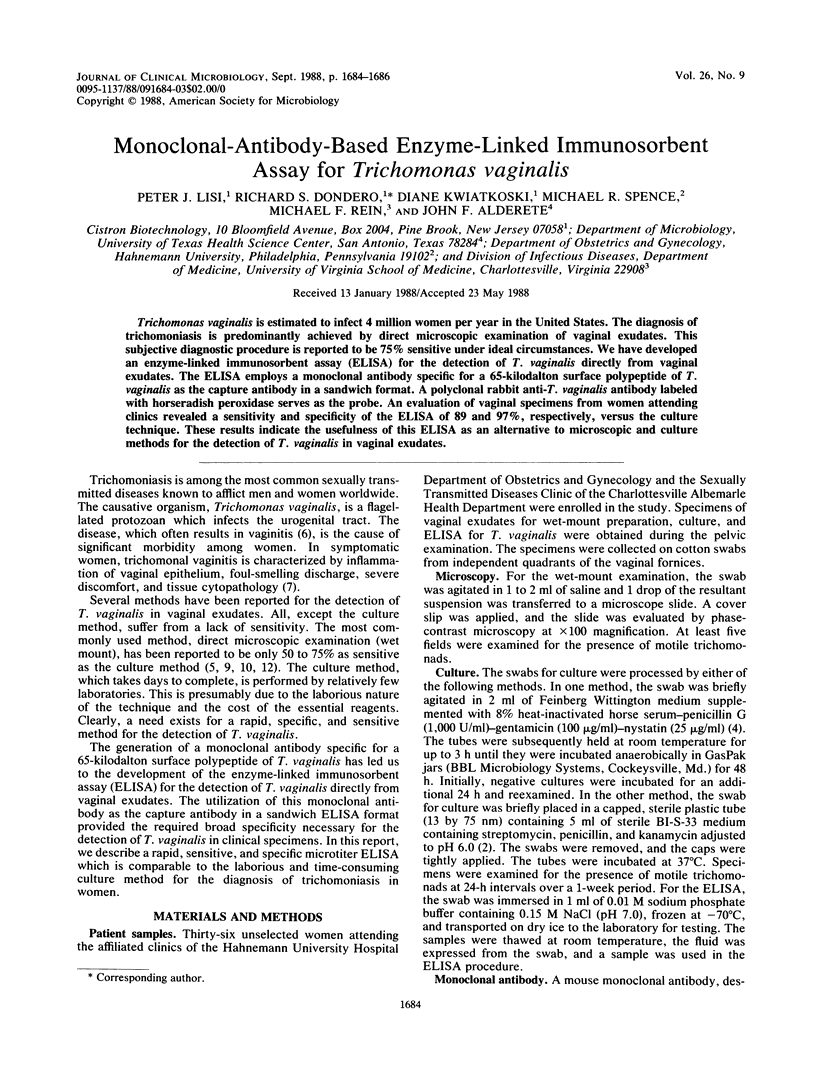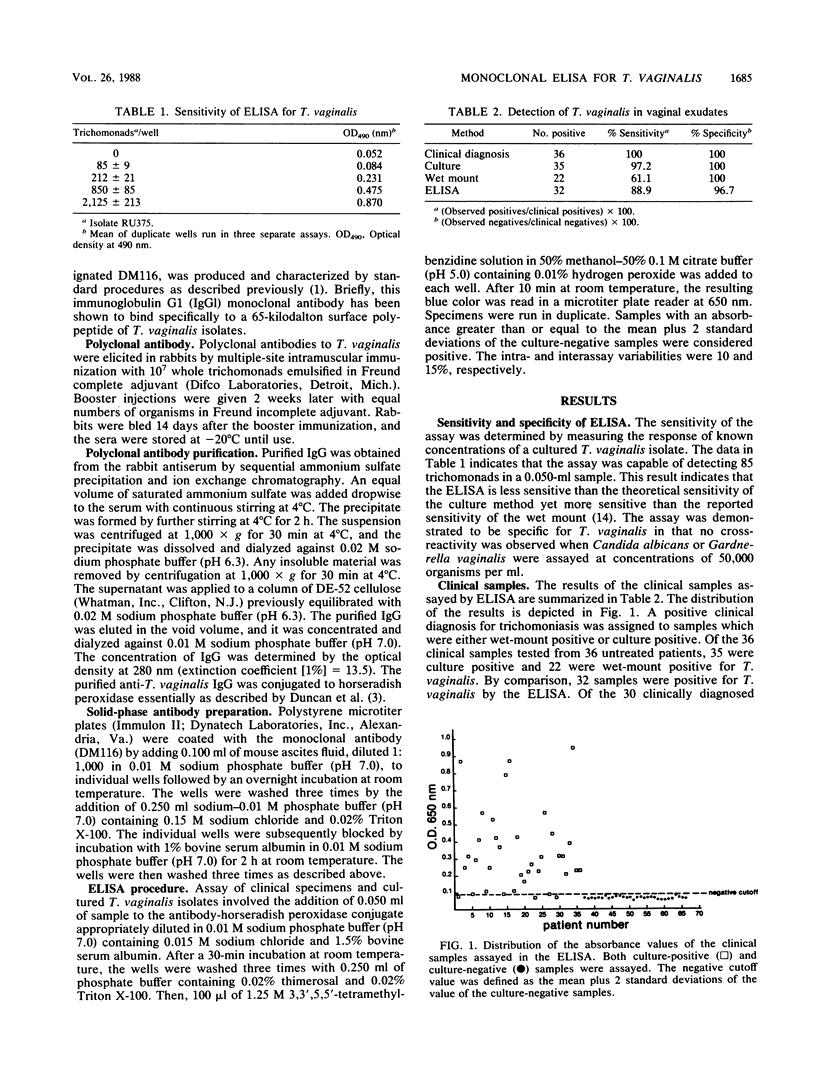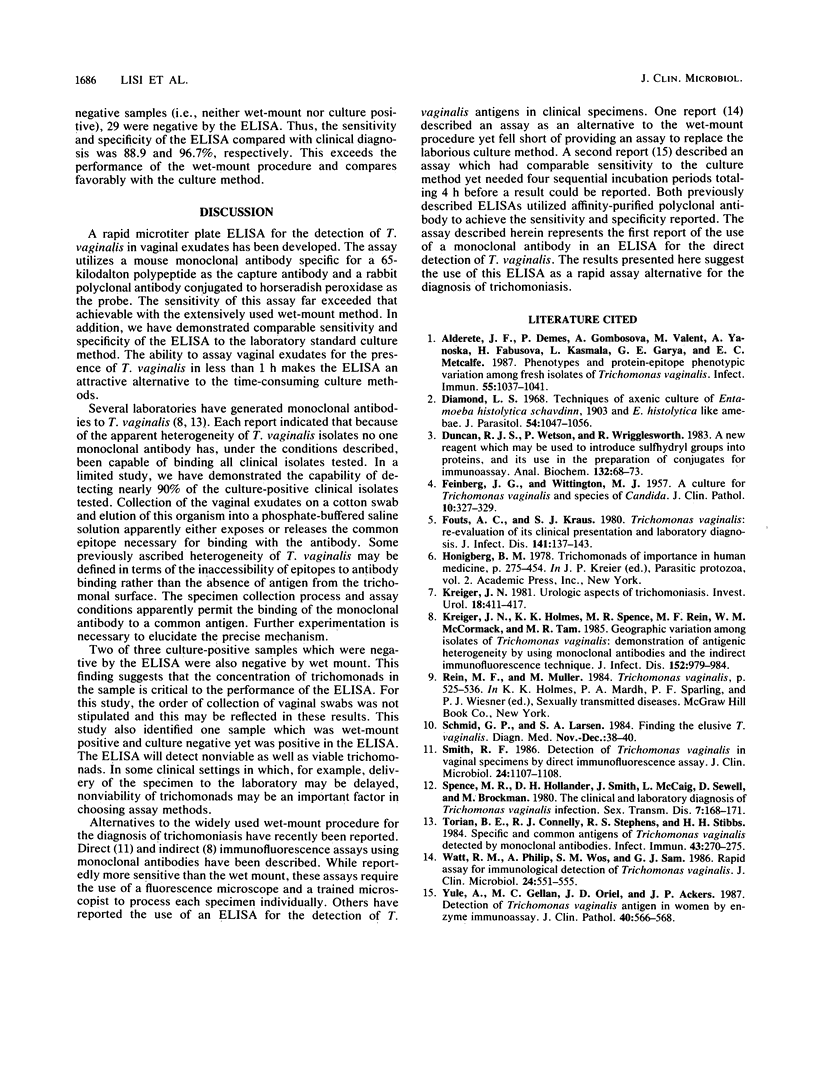Abstract
Trichomonas vaginalis is estimated to infect 4 million women per year in the United States. The diagnosis of trichomoniasis is predominantly achieved by direct microscopic examination of vaginal exudates. This subjective diagnostic procedure is reported to be 75% sensitive under ideal circumstances. We have developed an enzyme-linked immunosorbent assay (ELISA) for the detection of T. vaginalis directly from vaginal exudates. The ELISA employs a monoclonal antibody specific for a 65-kilodalton surface polypeptide of T. vaginalis as the capture antibody in a sandwich format. A polyclonal rabbit anti-T. vaginalis antibody labeled with horseradish peroxidase serves as the probe. An evaluation of vaginal specimens from women attending clinics revealed a sensitivity and specificity of the ELISA of 89 and 97%, respectively, versus the culture technique. These results indicate the usefulness of this ELISA as an alternative to microscopic and culture methods for the detection of T. vaginalis in vaginal exudates.
Full text
PDF


Selected References
These references are in PubMed. This may not be the complete list of references from this article.
- Alderete J. F., Demes P., Gombosová A., Valent M., Yánoska A., Fabusová H., Kasmala L., Garza G. E., Metcalfe E. C. Phenotypes and protein-epitope phenotypic variation among fresh isolates of Trichomonas vaginalis. Infect Immun. 1987 May;55(5):1037–1041. doi: 10.1128/iai.55.5.1037-1041.1987. [DOI] [PMC free article] [PubMed] [Google Scholar]
- Diamond L. S. Techniques of axenic cultivation of Entamoeba histolytica Schaudinn, 1903 and E. histolytica-like amebae. J Parasitol. 1968 Oct;54(5):1047–1056. [PubMed] [Google Scholar]
- Duncan R. J., Weston P. D., Wrigglesworth R. A new reagent which may be used to introduce sulfhydryl groups into proteins, and its use in the preparation of conjugates for immunoassay. Anal Biochem. 1983 Jul 1;132(1):68–73. doi: 10.1016/0003-2697(83)90426-8. [DOI] [PubMed] [Google Scholar]
- FEINBERG J. G., WHITTINGTON M. J. A culture medium for Trichomonas vaginalis donné and species of Candida. J Clin Pathol. 1957 Nov;10(4):327–329. doi: 10.1136/jcp.10.4.327. [DOI] [PMC free article] [PubMed] [Google Scholar]
- Fouts A. C., Kraus S. J. Trichomonas vaginalis: reevaluation of its clinical presentation and laboratory diagnosis. J Infect Dis. 1980 Feb;141(2):137–143. doi: 10.1093/infdis/141.2.137. [DOI] [PubMed] [Google Scholar]
- Krieger J. N., Holmes K. K., Spence M. R., Rein M. F., McCormack W. M., Tam M. R. Geographic variation among isolates of Trichomonas vaginalis: demonstration of antigenic heterogeneity by using monoclonal antibodies and the indirect immunofluorescence technique. J Infect Dis. 1985 Nov;152(5):979–984. doi: 10.1093/infdis/152.5.979. [DOI] [PubMed] [Google Scholar]
- Krieger J. N. Urologic aspects of trichomoniasis. Invest Urol. 1981 May;18(8):411–417. [PubMed] [Google Scholar]
- Smith R. F. Detection of Trichomonas vaginalis in vaginal specimens by direct immunofluorescence assay. J Clin Microbiol. 1986 Dec;24(6):1107–1108. doi: 10.1128/jcm.24.6.1107-1108.1986. [DOI] [PMC free article] [PubMed] [Google Scholar]
- Spence M. R., Hollander D. H., Smith J., McCaig L., Sewell D., Brockman M. The clinical and laboratory diagnosis of Trichomonas vaginalis infection. Sex Transm Dis. 1980 Oct-Dec;7(4):168–171. doi: 10.1097/00007435-198010000-00004. [DOI] [PubMed] [Google Scholar]
- Torian B. E., Connelly R. J., Stephens R. S., Stibbs H. H. Specific and common antigens of Trichomonas vaginalis detected by monoclonal antibodies. Infect Immun. 1984 Jan;43(1):270–275. doi: 10.1128/iai.43.1.270-275.1984. [DOI] [PMC free article] [PubMed] [Google Scholar]
- Watt R. M., Philip A., Wos S. M., Sam G. J. Rapid assay for immunological detection of Trichomonas vaginalis. J Clin Microbiol. 1986 Oct;24(4):551–555. doi: 10.1128/jcm.24.4.551-555.1986. [DOI] [PMC free article] [PubMed] [Google Scholar]
- Yule A., Gellan M. C., Oriel J. D., Ackers J. P. Detection of Trichomonas vaginalis antigen in women by enzyme immunoassay. J Clin Pathol. 1987 May;40(5):566–568. doi: 10.1136/jcp.40.5.566. [DOI] [PMC free article] [PubMed] [Google Scholar]


